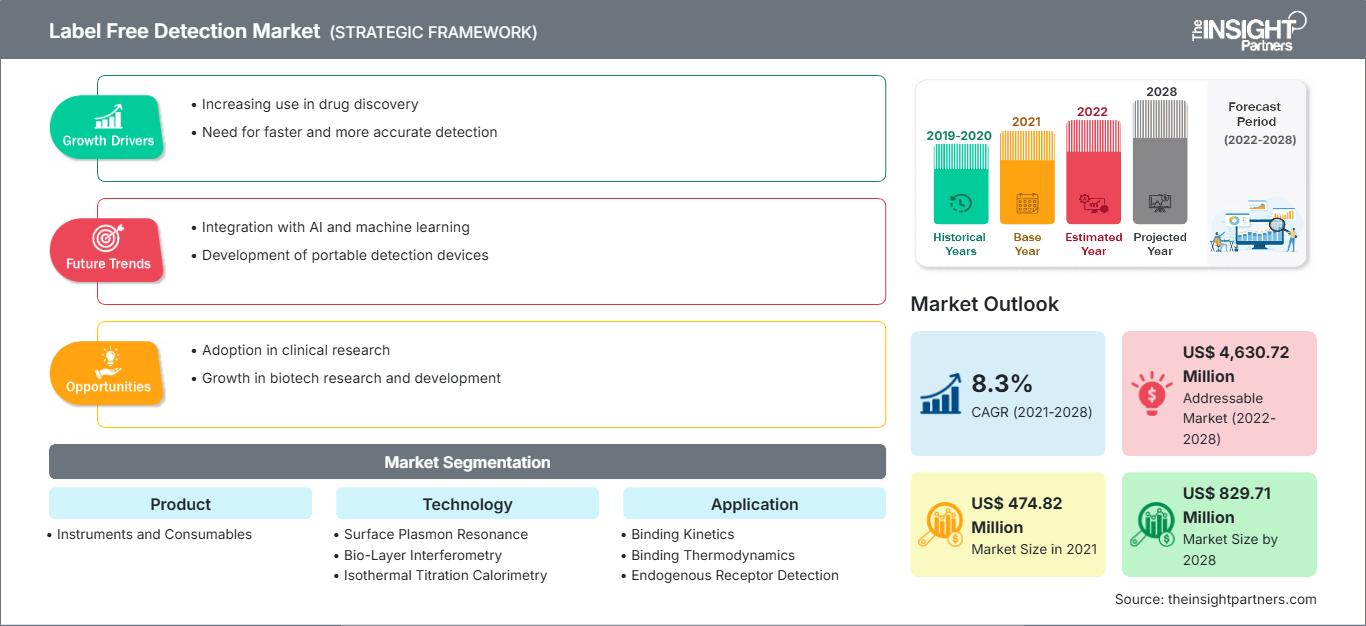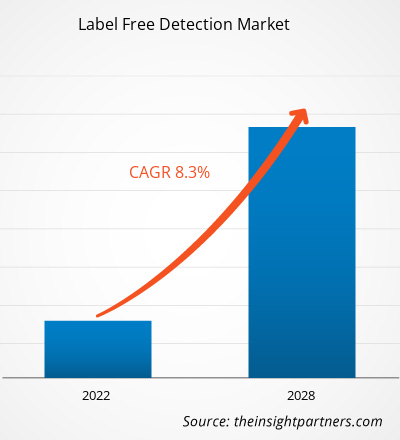Der Markt für markierungsfreie Detektion wird voraussichtlich von 474,82 Millionen US-Dollar im Jahr 2021 auf 829,71 Millionen US-Dollar im Jahr 2028 anwachsen; von 2021 bis 2028 wird ein CAGR von 8,3 % erwartet.
Die markierungsfreie Detektion (LFD) ist eine Technik zur Entdeckung von Biomolekülen und deren Wechselwirkungen. Diese Methode hat sich in der Pharma- und Biotechbranche zu einem attraktiven Forschungs- und Entwicklungsinstrument entwickelt. Die markierungsfreie Technologie nutzt impedanz- oder optisch basierte Biosensoren, um die Veränderungen bei der Bindung eines Analyten an einen auf einer Biosensoroberfläche immobilisierten Liganden zu messen. Dieser Ansatz ermöglicht die Überwachung der Wechselwirkung in Echtzeit, ohne die einzelnen Testkomponenten künstlich zu manipulieren. Ein entscheidendes Merkmal der markierungsfreien Technologie ist die zur Ligandenimmobilisierung verwendete Methode.
Der Markt für markierungsfreie Detektion ist nach Produkt, Technologie, Anwendung, Endnutzer und Geografie segmentiert. Der Markt ist geografisch grob in Nordamerika, Europa, Asien-Pazifik, den Nahen Osten und Afrika sowie Süd- und Mittelamerika unterteilt. Der Bericht bietet Einblicke und eine detaillierte Analyse des Marktes und betont Parameter wie Markttrends, technologische Fortschritte und Marktdynamik sowie die Analyse der Wettbewerbslandschaft der weltweit führenden Marktteilnehmer.
Markteinblicke
Steigende Zahl von Arzneimittelforschungsprogrammen durch akademisch-industrielle Partnerschaften fördert das Wachstum des Marktes für markierungsfreie Detektion im Prognosezeitraum
Direkte Partnerschaften zwischen Pharma-/Biotech-Unternehmen und akademischen Zentren werden immer beliebter. Für akademische Forscher und Forscher in der Pharmabranche liegen die Vorteile dieser Partnerschaften auf der Hand. Finanzielle Unterstützung durch die Pharmaindustrie bietet eine stetige Finanzierung und erhöht ihre Chance, wirkungsvolle Arbeit zu leisten. Diese Kooperationen können als Finanzierung der akademischen Forschung für vielversprechende Kandidaten beginnen. Die Strategie hilft Pharmaunternehmen, Lücken in ihrem Portfolio zu geringeren Kosten und Risiken zu schließen. Beispiele für innovative Kooperationen zwischen Wissenschaft und Industrie sind Takeda Pharmaceuticals mit der Universität Kyoto in Japan und der Stanford University in den USA sowie Sanofi mit der University of California, San Francisco (USA). Im Jahr 2020 arbeitete Creoptix mit Professor Adriano Aguzzi und der Universität Zürich zusammen, um SARS-CoV-2-Antikörper bei COVID-19-Patienten mithilfe des Creoptix WAVE-Systems zu analysieren. Die wachsende Zahl von Medikamentenforschungsprogrammen im Rahmen von Kooperationen zwischen Wissenschaft und Industrie treibt daher das Wachstum des Marktes für markierungsfreie Detektion voran.
Passen Sie diesen Bericht Ihren Anforderungen an
Sie erhalten kostenlos Anpassungen an jedem Bericht, einschließlich Teilen dieses Berichts oder einer Analyse auf Länderebene, eines Excel-Datenpakets sowie tolle Angebote und Rabatte für Start-ups und Universitäten.
Markt für etikettenfreie Erkennung: Strategische Einblicke

- Holen Sie sich die wichtigsten Markttrends aus diesem Bericht.Dieses KOSTENLOSE Beispiel umfasst Datenanalysen, die von Markttrends bis hin zu Schätzungen und Prognosen reichen.
Sie erhalten kostenlos Anpassungen an jedem Bericht, einschließlich Teilen dieses Berichts oder einer Analyse auf Länderebene, eines Excel-Datenpakets sowie tolle Angebote und Rabatte für Start-ups und Universitäten.
Markt für etikettenfreie Erkennung: Strategische Einblicke

- Holen Sie sich die wichtigsten Markttrends aus diesem Bericht.Dieses KOSTENLOSE Beispiel umfasst Datenanalysen, die von Markttrends bis hin zu Schätzungen und Prognosen reichen.
Produkteinblicke
Der globale Markt für markierungsfreie Detektion ist nach Produkten in Instrumente und Verbrauchsmaterialien unterteilt. Im Jahr 2021 hatte das Verbrauchsmaterialsegment den größten Marktanteil. Darüber hinaus wird für dasselbe Segment zwischen 2021 und 2028 die höchste durchschnittliche jährliche Wachstumsrate (CAGR) erwartet, was auf Faktoren wie die kontinuierliche Weiterentwicklung der markierungsfreien Detektionstechnologien und steigende staatliche Investitionen zur Förderung der Entwicklungen in den Bereichen Biopharmazie und Biotechnologie zurückzuführen ist.
Technologieeinblicke
Der globale Markt für markierungsfreie Detektion ist nach Technologien in Oberflächenplasmonenresonanz, Bioschichtinterferometrie, isotherme Titrationskalorimetrie, Differenzial-Scanning-Kalorimetrie und andere LFD-Technologien unterteilt. Im Jahr 2021 hatte das Technologiesegment Oberflächenplasmonenresonanz den größten Marktanteil. Darüber hinaus wird für dasselbe Segment zwischen 2021 und 2028 die höchste durchschnittliche jährliche Wachstumsrate (CAGR) erwartet. Dieses Wachstum ist auf die hohe Sensitivität dieser Technologie und ihre umfassende Anwendung bei der Regulierung von Spezifität, Affinität und kinetischen Parametern bei der Bindung von Makromolekülen zurückzuführen.
Anwendungseinblicke
Basierend auf der Anwendung ist der globale Markt für markierungsfreie Detektion in Bindungskinetik, Bindungsthermodynamik, endogene Rezeptordetektion, Trefferbestätigung, Lead-Generierung und andere Anwendungen unterteilt. Im Jahr 2021 hatte das Segment Bindungskinetik den größten Marktanteil. Darüber hinaus wird für dasselbe Segment zwischen 2021 und 2028 die höchste durchschnittliche jährliche Wachstumsrate (CAGR) erwartet. Die Faktoren, die zum Wachstum dieses Segments beitragen, sind der steigende Bedarf an Medikamenten mit breitem therapeutischen Index, Fortschritte in der Strukturbiologie und zunehmende F&E-Aktivitäten zum Nachweis von Coronaviren mit markierungsfreien Nachweismethoden.
Einblicke für Endnutzer
Basierend auf den Endnutzern ist der globale Markt für markierungsfreie Detektion in Pharma- und Biotechnologieunternehmen, Hochschul- und Forschungsinstitute, Auftragsforschungsinstitute und sonstige Endnutzer segmentiert. Im Jahr 2021 hatte das Segment der Pharma- und Biotechnologieunternehmen den größten Marktanteil. Darüber hinaus wird für dasselbe Segment zwischen 2021 und 2028 die höchste durchschnittliche jährliche Wachstumsrate (CAGR) auf dem Markt erwartet. Dieses Wachstum ist auf den umfassenden Einsatz markierungsfreier Detektionstechnologien durch Pharma- und Biotechnologieunternehmen zur Untersuchung biomolekularer Wechselwirkungen bei der Arzneimittelforschung zurückzuführen.
Produkteinführungen und Kooperationen sind bei den Akteuren des globalen Marktes für markierungsfreie Detektion häufig genutzte Strategien. Einige der wichtigsten Marktentwicklungen der letzten Zeit sind nachfolgend aufgeführt:
- Im August 2021 kündigte Agilent Technologies Inc. die Einführung des Agilent Seahorse XF Pro Analyzer an, der neue pharmaorientierte Workflow-Lösungen mit fortschrittlichen Tools für experimentelles Design und Analyse bietet.
- Im Januar 2022 gab Waters Corporation die Übernahme der Technologieanlagen und geistigen Eigentumsrechte von Megadalton Solutions, Inc. bekannt, einem frühen Entwickler von CDMS-Technologie (Charge Detection Mass Spectrometry) und -Dienstleistungen.
Die Gesamtauswirkungen von COVID-19 auf den nordamerikanischen Markt für markierungsfreie Detektion sind positiv. Dafür gab es verschiedene Faktoren, darunter die erhöhte Zahl COVID-19-positiver Patienten, Wachstum in der Forschung, eine steigende Impfstoffproduktion, Ergebnisstudien zu verabreichten Impfstoffen und viele weitere. So zeigte beispielsweise eine im Journal of American Chemical Society (JACS) veröffentlichte Studie die markierungsfreie digitale Detektion intakter Virionen. Die Studie ergab, dass die markierungsfreie Biosensorik intakte Viren im menschlichen Speichel schnell und mit Einzelvirionenauflösung nachweisen und quantifizieren konnte. Diese Fälle führten maßgeblich zu einer Nachfrage nach neuen Diagnosemethoden in Ländern wie den USA, Kanada und Mexiko. Daher wird der Markt für markierungsfreie Detektion in Nordamerika durch COVID-19 positiv beeinflusst.
Markierungsfreie DetektionRegionale Einblicke in den Markt für markierungsfreie Detektion
Die Analysten von The Insight Partners haben die regionalen Trends und Faktoren, die den Markt für etikettenfreie Detektion im Prognosezeitraum beeinflussen, ausführlich erläutert. In diesem Abschnitt werden auch die Marktsegmente und die geografische Lage in Nordamerika, Europa, dem asiatisch-pazifischen Raum, dem Nahen Osten und Afrika sowie Süd- und Mittelamerika erörtert.
Umfang des Marktberichts zur markierungsfreien Detektion
| Berichtsattribut | Einzelheiten |
|---|---|
| Marktgröße in 2021 | US$ 474.82 Million |
| Marktgröße nach 2028 | US$ 829.71 Million |
| Globale CAGR (2021 - 2028) | 8.3% |
| Historische Daten | 2019-2020 |
| Prognosezeitraum | 2022-2028 |
| Abgedeckte Segmente |
By Produkt
|
| Abgedeckte Regionen und Länder | Nordamerika
|
| Marktführer und wichtige Unternehmensprofile |
|
Dichte der Marktteilnehmer für markierungsfreie Detektion: Verständnis ihrer Auswirkungen auf die Geschäftsdynamik
Der Markt für etikettenfreie Detektion wächst rasant. Die steigende Nachfrage der Endverbraucher ist auf Faktoren wie veränderte Verbraucherpräferenzen, technologische Fortschritte und ein stärkeres Bewusstsein für die Produktvorteile zurückzuführen. Mit der steigenden Nachfrage erweitern Unternehmen ihr Angebot, entwickeln Innovationen, um den Bedürfnissen der Verbraucher gerecht zu werden, und nutzen neue Trends, was das Marktwachstum weiter ankurbelt.

- Holen Sie sich die Markt für etikettenfreie Erkennung Übersicht der wichtigsten Akteure
Markierungsfreie Detektion – Marktsegmentierung
Der globale Markt für markierungsfreie Detektion ist nach Produkt, Technologie, Anwendung, Endnutzer und Geografie segmentiert. Produktseitig ist der Markt in Instrumente und Verbrauchsmaterialien unterteilt. Technologieseitig ist der Markt für markierungsfreie Detektion in Oberflächenplasmonenresonanz, Bioschichtinterferometrie, isotherme Titrationskalorimetrie, Differenzial-Scanning-Kalorimetrie und andere LFD-Technologien unterteilt. Anwendungsseitig ist der Markt in Bindungskinetik, Bindungsthermodynamik, endogene Rezeptordetektion, Trefferbestätigung, Lead-Generierung und andere Anwendungen unterteilt. Endnutzerseitig ist der Markt für markierungsfreie Detektion in Pharma- und Biotechnologieunternehmen, Hochschul- und Forschungsinstitute, Auftragsforschungsinstitute und andere Endnutzer segmentiert. Geografisch ist der Markt grob in Nordamerika, Europa, Asien-Pazifik, Naher Osten und Afrika sowie Süd- und Mittelamerika unterteilt.
Unternehmensprofile
- General Electric
- Perkin Elmer, Inc.
- AMETEK Inc.
- F. HOFFMANN-LA ROCHE LTD
- Spectris
- METTLER TOLEDO
- Agilent Technologies, Inc.
- Waters Corporation
- Sartorius AG
- Corning Incorporated
- Historische Analyse (2 Jahre), Basisjahr, Prognose (7 Jahre) mit CAGR
- PEST- und SWOT-Analyse
- Marktgröße Wert/Volumen – Global, Regional, Land
- Branchen- und Wettbewerbslandschaft
- Excel-Datensatz
Aktuelle Berichte
Verwandte Berichte
Erfahrungsberichte
Grund zum Kauf
- Fundierte Entscheidungsfindung
- Marktdynamik verstehen
- Wettbewerbsanalyse
- Kundeneinblicke
- Marktprognosen
- Risikominimierung
- Strategische Planung
- Investitionsbegründung
- Identifizierung neuer Märkte
- Verbesserung von Marketingstrategien
- Steigerung der Betriebseffizienz
- Anpassung an regulatorische Trends






















 Kostenlose Probe anfordern für - Markt für etikettenfreie Erkennung
Kostenlose Probe anfordern für - Markt für etikettenfreie Erkennung